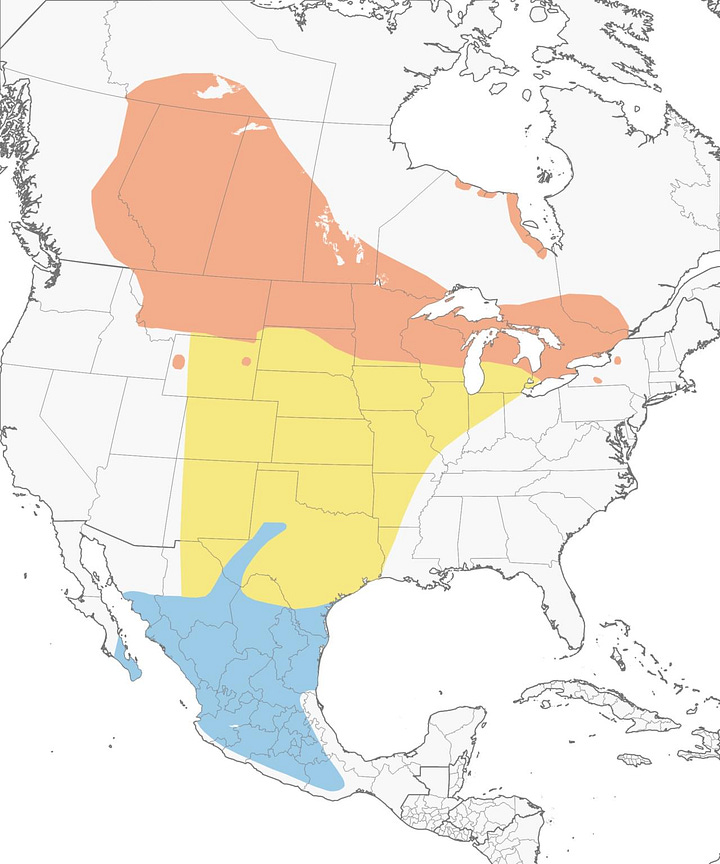MICROSEASON — OCT 14 - OCT 20
The Noticer's Monthly #32 — City of Forest Day, double hawk-tendre, side quests, and more
Howdy, hairballs.
Mark your calendar — Next Saturday, October 26, a few of us will be over at McCarren Demo Garden from approx. 8:30 - 9:30am. The occasion? City of Forest Day, a citywide celebration designed to raise awareness for NYC’s urban forests. Parsley Steinweiss will lead McGolrick’s regularly scheduled 9am walk, with Michael sprinting back 30 min. or so late.
MICRO-SEASON OCT 14 - OCT 20
Current Japanese micro-season: "Chrysanthemums bloom". As for McGolrick Park, New York City and perhaps even larger swathes of the eastern US, we notice—
American Woodcock returns · Cooper’s Hawk returns · Mixed sparrow flocks · First of season Fox Sparrow · First of season winter jackets, mittens
BIRD REPORT
Who’d we notice in McGolrick Park this micro-season?
American Woodcock · Yellow-rumped Warbler · Cooper’s Hawk · Tufted Titmouse · White-breasted Nuthatch · Palm Warbler · Fox Sparrow · White-throated Sparrow · Song Sparrow · Chipping Sparrow · Swamp Sparrow · Eastern Towhee · Eastern Phoebe · Hermit Thrush · Great Blue Heron · Brown Creeper · Ruby-crowned Kinglet · Golden-crowned Kinglet · Downy Woodpecker · Red-bellied Woodpecker · Yellow-bellied Sapsucker · Northern Flicker · Red-tailed Hawk · Blue-headed Vireo · Blackpoll Warbler · American Redstart · Dark-eyed Junco · Chipping Sparrow · Northern Mockingbird · Common Yellowthroat · Canada Goose · American Kestrel · Cedar Waxwing · Blue Jay · Northern Cardinal · Common Grackle · American Crow · Rock Pigeon · European Starling · American Robin · House Sparrow · Mourning Dove

Feel like you’re missing the migration gods’ missionaries? For the rest of October, join us on Tuesday and Friday mornings, when birds are most active, starting around 7am. Just show up
Note that some of the above birds were seen wearing their “Female” plumage—what migrating birds of both sexes often sport in fall
ON NOTICE
Coop, coop ba-doop, Coop ba-doop, Coop ba-doop, ba-doop, ba-doop
Cooper’s Hawk are increasingly noticeable in NYC this time o’ year. Coops have longer, stripier tails than Red-tailed Hawks. They’re sleeker too. Adults have dark gray tops and orange dappled fronts. Their look in flight is a sort of flap-flap-glide that, because of the aforementioned tail, is giving flying cross.
Don’t overthink it. Go outside and notice a Cooper’s right now.
BONUS —Juveniles aren’t yet orange washed, and wear brown teardrop shapes:
MICRO-LESSON: RARE BIRD ALERT
Wanna take a giant step towards bird-nerdom?
Sign-up for eBird’s Rare Bird Alerts. Input your county name (that’s county, not country) then hit Subscribe. This will initiate an approx. daily email featuring recent, unusual bird sightings. The emails to Brooklynites look like this:
Rare can be in terms of place or time. Birds like the Clay-colored Sparrow, for example, are always rare in Brooklyn. Scarlet Tanagers, though expected in NYC during spring and fall migrations, are rare to Brooklyn this late in October.


Below the email summaries are details, such as the location of the encounter, and, occasionally, comments featuring descriptive details plus exactly where/how the bird was found. Because rarities often linger in or around specific places, these details can help you relocate the unusual birds on your own.
Subscribe to Rare Bird Alerts! Side quest for a rarity! Treasures await ye in the anomalous now!
EPILOGUE
Whether enjoyment or hate-reading brought you this far down the page, HELLO and THANKS for your attention! If you haven’t yet done so, please like and share this newsletter, or subscribe to the ~$4/ month paid tier. For a measly few bucks every lunar cycle—what, like, the cost of a coffee?—you get perks such as access to members-only events and a free piece o’ signature merchandise! Plus you help to support McGolrick Bird Club and this digital digest. Eternal thanks!










